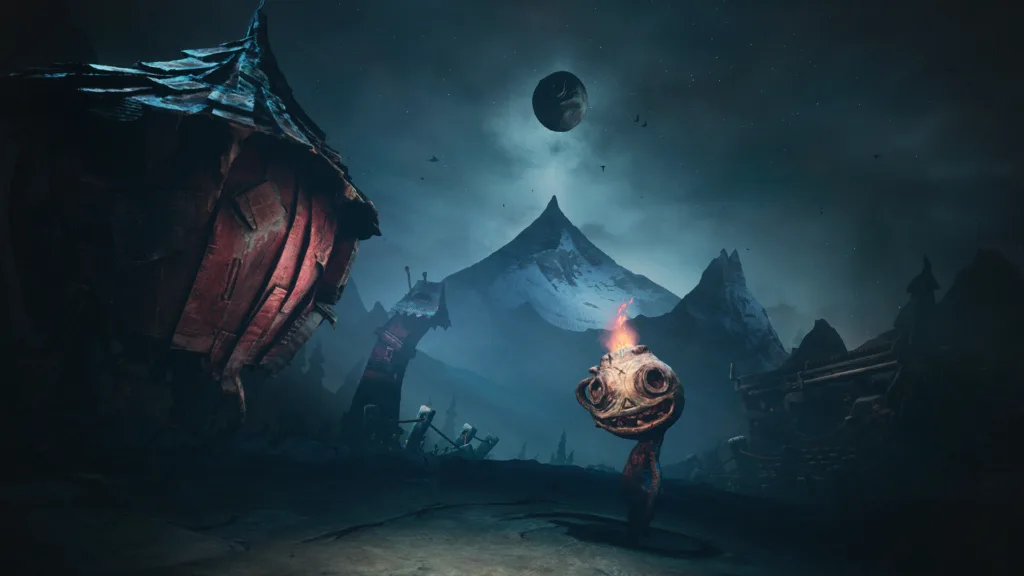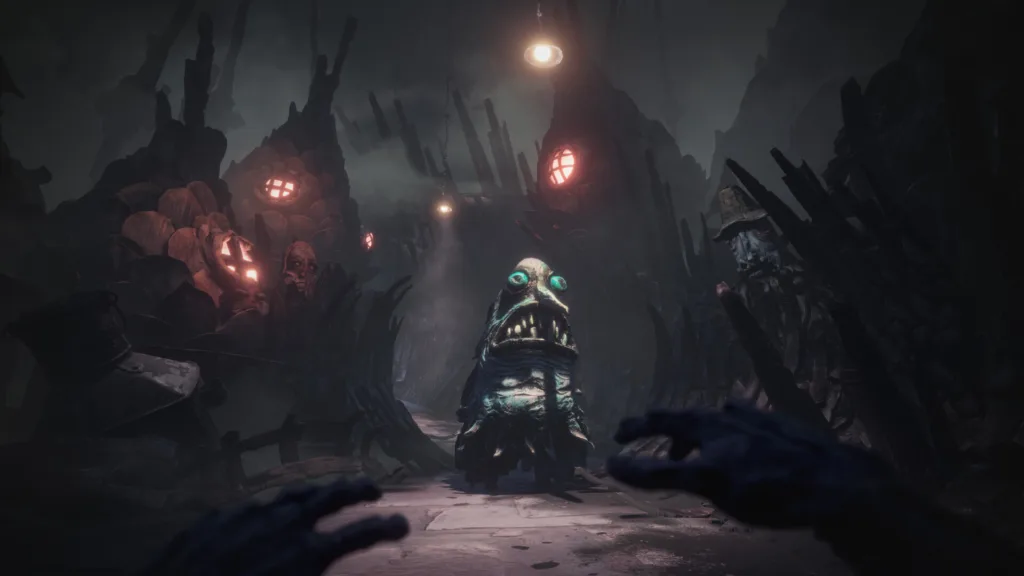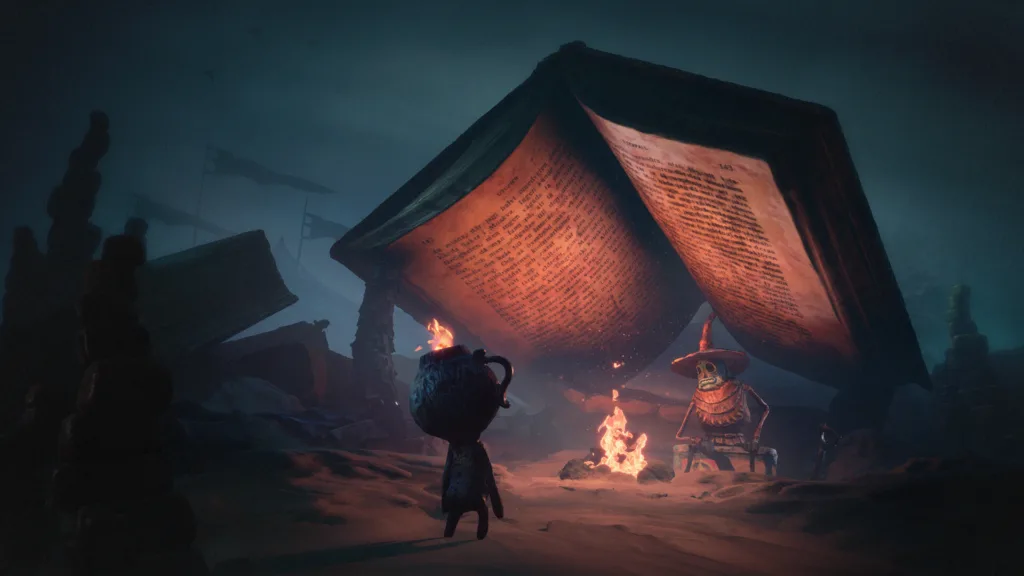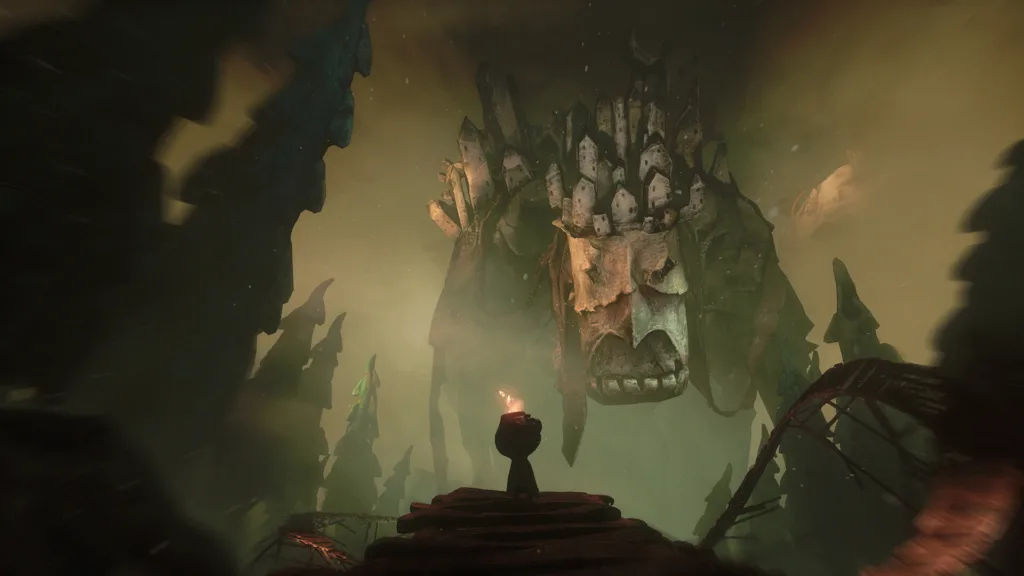From the first flicker of a match in utter darkness, The Midnight Walk beckons you into a world that feels lifted from a claymation nightmare—equal parts Grimm fairy tale and gothic whimsy. Its stop‑motion aesthetic lends every shadowy corridor and grotesque crawler an unsettling yet beautiful life, drawing you into a realm where fire is both salvation and threat.
You assume the mantle of the Burnt One, a silent, embers‑scarred figure resurrected with only a flicker of purpose: escort your diminutive companion, Potboy, whose living flame is the key to awakening Moon Mountain. Together, you’ll thread through five haunting vignettes—each a self‑contained tale of loss, regret, and flickering hope—using nothing but matches, a match‑shooting pistol, and Potboy’s loyalty to light your path.
Designed for both VR headsets (SteamVR, PSVR2) and traditional screens, the game’s first‑person viewpoint marries immersive audio cues—where closing your eyes can reveal hidden truths—with light stealth and environmental puzzles that never outstay their welcome. Clocking in around 4–8 hours, The Midnight Walk invites both narrative‑curious players and seasoned indie‑RPG fans to experience its measured blend of tension and wonder in a single, unforgettable journey.
Kindling the Narrative: Mechanics Meets Myth
The Midnight Walk structures its story around a central hub—an ever‑burning trail where your journey pauses between five thematically distinct “tales.” This framing device not only provides brief respites from creeping dread but reinforces the cyclical nature of the game’s world: each return to the Midnight Walk feels like turning a page in a storybook, priming you for the next chapter’s moral parable. Much like the chapter‑based design in indie gems such as Journey, these discrete vignettes let Moonhood experiment with tone and setting without losing narrative cohesion.
Your journey begins with the Burnt One’s resurrection, a wordless incitement that casts you as both pilgrim and witness. Early milestones—reuniting Potboy with his flame, your first audience with the two‑headed Soothsayers—double as mechanical tutorials: lighting matches to solve puzzles and listening through closed eyes to reveal hidden paths. Encounters with figures like the enigmatic Soulfisher layer in lore without resorting to cutscenes, mirroring the environmental storytelling of Firewatch or Gone Home. By the time you learn that “all has happened before,” these mechanics have woven story and gameplay into a single, seamless experience.
Despite its linear spine, the game offers a subtle form of player agency through exploration. Optional Shellphones scattered across levels serve as both collectibles and expository devices: choosing to hunt them down deepens your understanding of character motivations and later influences which of the dual endings you witness. Though not a branching narrative in the traditional RPG sense, these exploration choices carry weight—rewarding meticulous players with richer emotional payoffs.
Moonhood’s minimal exposition demands inference over explicit lore dumps. Silent‑film projections and audio logs replace encyclopedic journals, while pacing alternates between stealth‑fueled tension and quiet moments by candlelight. This balance keeps players—both casual and hardcore—engaged without overwhelming them with jargon or needless complexity.
At its core, The Midnight Walk is a study in contrasts: fire as creation and destruction, grief giving way to hope, destiny trapped within a loop yet offering sparks of redemption. Memorable moments—restoring Nobodyville’s bodies or cradling a resigned Potboy as his flame wanes—linger because the game has earned them through intertwined mechanics and narrative beats. In marrying its systems to its themes, Moonhood doesn’t just tell a story; it lets you live its flickering heart.
Playing with Fire and Darkness
Behind every lit candle in The Midnight Walk lies a layered system of mechanics that never feels tacked on—each interaction reinforces the narrative’s tension and themes.
At its heart, the game revolves around fire management. You ignite matches individually, wield a match‑shooting pistol for distant flames, and rely on Potboy’s living ember to keep candles burning. This triad feels tactile yet strategic: conserving matches in one chapter pays dividends in the next. Stealth hinges on the familiar wardrobe‑hiding trope, but elevated by spatial audio—listen for monster breath and scuttle, then close your eyes to erase doors or obstacles, a mechanic as inventive as BioShock’s “It Ends Tonight” plasmids. Environmental puzzles consistently loop back to fire: char a chain to lower a bridge, burn brambles to clear paths, or guide Potboy onto pressure plates.
The eye‑closing mechanic is the game’s signature flourish. Rather than pause the action, shutting your eyes (physically in VR or via trigger on flat screen) actively reshapes the world: statues animate, keys materialize, even foes revert to harmless stone. It’s a rare case where pausing becomes participatory, recalling the scope‑bending moments of The Unfinished Swan. Spatial‑audio challenges push this further—tracking a hidden switch by sound alone evokes Hellblade’s binaural cues, yet never feels gimmicky, since the narrative casts your blindness as both vulnerability and power.
Puzzles are intuitive—clear a flame to solve a riddle—but occasionally loop into repetition, particularly late‑game candle sequences that echo earlier tasks. Stealth segments deliver genuine tension—monster patrol routes demand patience, yet generous checkpoints soften frustration, striking a middle ground between Alien: Isolation’s brutality and Gone Home’s laid‑back exploration.
On flat screens, eye‑closing maps to a button hold; in VR, you physically blink, grounding you in the Burnt One’s experience. Grabs snap reliably, matches arc naturally, and Potboy responds with a satisfying lag that underscores his trust in you. Neither mode ever feels tacked on—VR heightens immersion, but flat‑screen inputs remain crisp and accessible for non‑headset players.
The hub‑and‑chapter structure punctuates each segment with a moment to catch your breath—both narratively and mechanically. However, by the final act, the fire‑puzzle loop can induce mild fatigue. Yet, the promise of the next narrative beat keeps you lighting match after match, drawn onward by the interplay of fear and wonder.
A Symphony of Clay and Shadows
Moonhood’s commitment to handcrafted artistry is evident the moment you step into its world: every model feels sculpted by human hands, then flawlessly digitized. Characters and creatures bear the fingerprints of claymation tradition, combining the warmth of tangible materials with the uncanny grace of stop‑motion. This blend of beauty and grotesque calls to mind the tactile charm of Little Nightmares, yet remains uniquely its own.
The Midnight Walk hub offers a breath of safety—a lantern‑lit clearing where the Burnt One pauses between chapters. Here, warmth radiates not just from candles but from ambient details: rustling embers, mossy stones, and distant, echoing footsteps. Each chapter then whisks you into a new tableau—a village of disembodied heads that stare accusingly from crooked rooftops, vast moonlit arches that defy Euclidean logic, and latter‑game vistas of impossibly towering spires. The shift in scale—from intimate corridors to cathedral‑sized expanses—mirrors the narrative’s ascent toward revelation.
Monster design marries whimsy with horror. Crawlers and Grinners move with jarringly stuttered grace, their extra limbs twitching in glitch‑like rhythms that underscore your vulnerability. Player‑friendly NPCs—like the two‑headed Soothsayers, whose dual gazes foretell fire’s dual nature, or Housy the walking house, a mobile sanctuary—anchor the emotional stakes, each silhouette artfully distinct against the darkness.
Lighting and shadow are more than aesthetics; they’re gameplay. Dynamic flame flicker shapes your path and your fear, casting dancing silhouettes that beckon or betray. Darkness isn’t just absence of light but an active agent of suspense, closing in until a match’s spark casts it back.
The audio design intertwines with these visuals to elevate the narrative. Subtle narration and Potboy’s soft chirps give personality to silence, while a string‑driven score weaves melancholy through sparse piano motifs and occasional brass flourishes. Spatial audio in VR magnifies every creak and whisper, turning simple footsteps into directional cues and transforming each echo into an invitation—or a warning. Together, clay and candlelight converge into an atmosphere that feels as alive as it is haunted.
Paths of Ash and Story
Moonhood structures The Midnight Walk around a central hub—the eponymous Midnight Walk—that threads together five self‑contained chapters. This safe haven not only offers a moment to catch your breath but reinforces the game’s cyclical themes: return, reflection, and renewal. Progression is linear, yet optional Shellphones scattered in each level invite deeper exploration, granting both lore and a subtle form of player agency.
Environmental storytelling takes center stage through intricately placed artifacts and audio logs. Shellphones unlock whispered anecdotes, while weathered signs and broken pottery hint at each locale’s tragedy. Repeating visual motifs—flickering embers, charred vines, and spiraling ash—serve as breadcrumbs, guiding you through themes of decay and rebirth much like the runic markers in Hyper Light Drifter.
Each chapter introduces a distinct tableau. Nobodyville’s floating heads cast judgment from every ledge, their hollow stares evoking Limbo’s haunting silhouettes. The Molgrim encounter pits your helplessness against ravenous beasts, balancing stealth and urgency. In Craftman’s Heart, a silent‑film projection weaves a meta‑narrative over clay‑sculpted stages, merging gameplay and cutscene into one cohesive moment.
Replayability hinges on mechanics tied to your senses: closing your eyes dissolves walls to reveal secret alcoves, while well‑timed fires ignite hidden platforms. These layered puzzles reward meticulous listening and observation more than reflexes. By weaving collectibles, sensory mechanics, and distinct chapter themes into its level design, The Midnight Walk cultivates a world that feels both meticulously crafted and alive with untold stories.
Embers of Companionship
The Burnt One arrives as a blank slate—voiceless, eyeless, and earless until you reclaim your senses. This silent protagonist recalls the player projection models of titles like Limbo, yet carries messianic undertones: you’re not just exploring; you’re the catalyst for reigniting a world consumed by darkness. Your agency emerges through subtle gestures—where you look, which Shellphones you pursue, and how you guide Potboy—blurring the line between passive observer and active redeemer.
At the heart of The Midnight Walk is Potboy, whose living flame evolves from a tremulous spark to a reliable partner. Early on, you summon him to light candles or distract foes; later, his trust underpins pivotal story moments. This functional bond mirrors companion mechanics in Brothers: A Tale of Two Sons, but here, Potboy’s vulnerability makes each command feel consequential—lose his flame, and progression stalls, heightening every choice to send him forward or shield him from harm.
Supporting characters reinforce this dynamic. Housy, your walking house, doubles as both narrative sanctuary and inventory mechanic—store rare finds in its belly while gleaning comfort from its creaking walls. The two‑headed Soothsayers and the solitary Soulfisher act as philosophical waypoints, dispensing cryptic guidance that you choose to heed or ignore. Ancillary figures—a grieving last‑of‑its‑kind creature, resentful villagers—offer optional interactions that deepen emotional stakes without derailing the main path.
Character design and claymation animation foster genuine attachment; Potboy’s quivering form and Housy’s anthropomorphic sway evoke empathy beyond text or dialogue. Trust emerges not from cutscenes but from gameplay itself: each successful puzzle solved with Potboy, each safe return to Housy, cements your bond—and leaves you questioning what darkness you’d endure to protect a single spark.
Perspective Shift: VR vs. Flat‑Screen
In VR, The Midnight Walk transforms into a visceral ritual: you physically strike matches and blink your headset’s view to reshape the world. The scale of towering spires and looming monsters becomes palpable—each creak of a wardrobe sends a shiver down your spine. However, seated play can introduce neck strain and occasional reach issues, nudging you toward standing for full immersion.
On flat screens, the eye‑closing mechanic maps to a simple trigger‑hold, preserving puzzle flow without the physical demand. While some of VR’s tactile wonder fades, the core narrative and claymation visuals remain striking. The streamlined interface and traditional controls make it accessible to players who lack headsets or prefer a couch‑friendly experience.
Performance and comfort feel polished across both modes. Frame rates hold steady even in visually dense scenes, and loading pauses rarely disrupt tension. Motion comfort options—such as snap‑turning and vignette effects—keep VR sickness at bay, while subtitles and remappable controls ensure that players of varying needs can tailor their experience.
For the deepest sense of presence, PSVR2 and Steam VR shine, leveraging 6DOF tracking for precise interactions. Yet on PC and console without a headset, the game still delivers its haunting atmosphere and narrative beats intact—proof that Moonhood designed for both front‑row immersion and theater‑style play.
Flickers Beyond the Horizon
Moonhood has delivered a hauntingly beautiful tapestry where handcrafted claymation art, whisper‑soft narration, and inventive mechanics coalesce into a singular experience. The strengths are undeniable: its thematic synergy of fire and darkness, emotionally resonant companion dynamics with Potboy, and the atmospheric tension woven through every puzzle and stealth sequence. Yet, the recurrent fire‑puzzle loops and occasional stealth backtracking sit at odds with the narrative’s momentum, inviting mild fatigue in the final chapters.
This is a journey tailor‑made for lovers of narrative‑driven adventures, indie RPG aficionados who appreciate mechanical nuance, and VR enthusiasts chasing presence that transcends the headset. Even on flat screens, its world holds enough mystery to satisfy casual explorers and lore hunters alike.
With two distinct endings and hidden Shellphones that deepen the story, The Midnight Walk beckons you back—whether to unearth every whispered secret or re‑experience that climactic spark of revelation.
Step into the shadowed trail one more time, light a match, and discover how far a single ember can carry you into the heart of the night.
The Review
The Midnight Walk
The Midnight Walk is a gorgeously crafted narrative journey where handcrafted claymation visuals, haunting audio, and inventive mechanics fuse to deliver emotional depth and atmospheric tension. Its light‑stealth puzzles and sensory‑driven exploration may feel repetitive late‑game, but Potboy’s companionship and the game’s thematic interplay of fire and darkness leave a lasting impression.
PROS
- Stunning claymation‑style visuals that feel handcrafted
- Innovative eye‑closing and spatial audio mechanics
- Innovative eye‑closing and spatial audio mechanics
- Emotional core driven by Potboy companion dynamics
- Dual endings and hidden collectibles boost replay value
CONS
- Fire‑based puzzles can become repetitive
- Occasional stealth backtracking disrupts pacing
- Limited mechanical variety beyond core loops
- Short overall runtime for those seeking length





















































